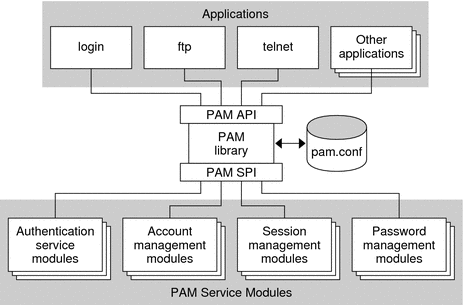PAM (Overview)
The Pluggable Authentication Module (PAM) framework lets you “plug in” new authentication services without changing system entry services, such as login, ftp, and telnet. You can also use PAM to integrate UNIX login with other security mechanisms such as Kerberos. Mechanisms for account, credential, session, and password management can also be “plugged in” by using this framework.
Benefits of Using PAM
The PAM framework enables you to configure the use of system entry services (such as, ftp, login, telnet, or rsh) for user authentication. Some benefits that PAM provides are as follows:
-
Flexible configuration policy
-
Per-application authentication policy
-
The ability to choose a default authentication mechanism
-
The ability to require multiple authorizations on high-security systems
-
-
Ease of use for the end user
-
No retyping of passwords if the passwords are the same for different authentication services
-
The ability to prompt the user for passwords for multiple authentication services without requiring the user to type multiple commands
-
-
The ability to pass optional options to the user authentication services
-
The ability to implement a site-specific security policy without having to change the system entry services
Introduction to the PAM Framework
The PAM framework consists of four parts:
-
PAM consumers
-
PAM library
-
The pam.conf(4) configuration file
-
PAM service modules, also referred to as providers
The framework provides a uniform way for authentication-related activities to take place. This approach enables application developers to use PAM services without having to know the semantics of the policy. Algorithms are centrally supplied. The algorithms can be modified independently of the individual applications. With PAM, administrators can tailor the authentication process to the needs of a particular system without having to change any applications. Adjustments are made through pam.conf, the PAM configuration file.
The following figure illustrates the PAM architecture. Applications communicate with the PAM library through the PAM application programming interface (API). PAM modules communicate with the PAM library through the PAM service provider interface (SPI). Thus, the PAM library enables applications and modules to communicate with each other.
Figure 17–1 PAM Architecture

Changes to PAM for the Solaris 10 Release
The Solaris 10 release includes the following changes to the Pluggable Authentication Module (PAM) framework:
-
The pam_authtok_check module now allows for strict password checking using new tunable parameters in the /etc/default/passwd file. The new parameters define:
-
A list of comma separated dictionary files used for checking common dictionary words in a password
-
The minimum differences required between a new password and an old password
-
The minimum number of alphabetic or nonalphabetic characters that must be used in a new password
-
The minimum number of uppercase or lowercase letters that must be used in a new password
-
The number of allowable consecutive repeating characters
-
-
The pam_unix_auth module implements account locking for local users. Account locking is enabled by the LOCK_AFTER_RETRIES parameter in /etc/security/policy.conf and the lock_after-retries key in /etc/user_attr. See the policy.conf(4) and the user_attr(4) man pages for more information.
-
A new binding control flag has been defined. This control flag is documented in the pam.conf(4) man page and in How PAM Stacking Works.
-
The pam_unix module has been removed and replaced by a set of service modules of equivalent or greater functionality. Many of these modules were introduced in the Solaris 9 release. Here is a list of the replacement modules:
-
pam_authtok_check
-
pam_authtok_get
-
pam_authtok_store
-
pam_dhkeys
-
pam_passwd_auth
-
pam_unix_account
-
pam_unix_auth
-
pam_unix_cred
-
pam_unix_session
-
-
The functionality of the pam_unix_auth module has been split into two modules. The pam_unix_auth module now verifies that the password is correct for the user. The new pam_unix_cred module provides functions that establish user credential information.
-
Additions to the pam_krb5 module have been made to manage the Kerberos credentials cache using the PAM framework.
-
A new pam_deny module has been added. The module can be used to deny access to services. By default, the pam_deny module is not used. For more information, see the pam_deny(5) man page.
Changes to PAM for the Solaris Express 1/06 Release
The PAM framework for the Solaris Express 1/06 release includes a new pam_allow module. The module can be used to grant access to all users, without enforcing any security. The module should be used with caution. For more information, see the pam_allow(5) man page.
- © 2010, Oracle Corporation and/or its affiliates
